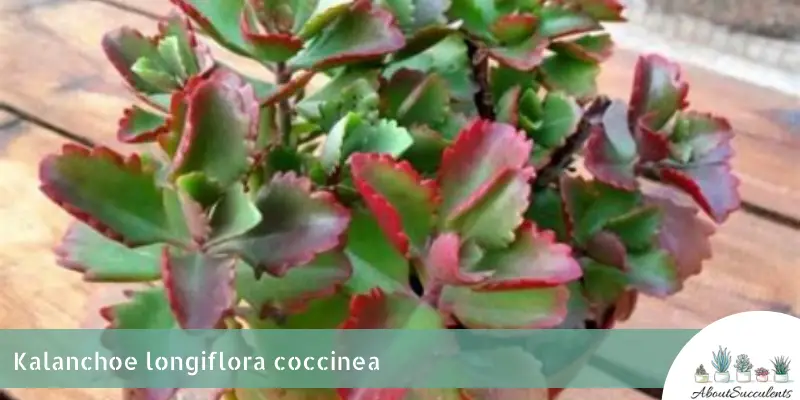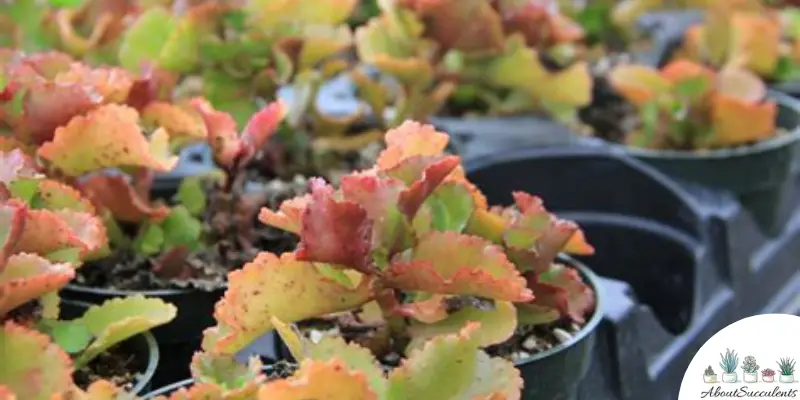
Kalanchoe Longiflora Coccinea’s beauty has been described as “unusual”, “odd”, and “unique” but many horticulturists continue to grow this succulent because of the strikingly charming foliage and flowers that can appear in a variety of colors.
Also known as Tugela Cliff Kalanchoe and Long Flower Kalanchoe, this succulent plant is native to South Africa where it can be seen growing along the cliffside of the Tugela basin. You can also find this Kalanchoe growing in Madagascar.
At maturity, Kalanchoe Longiflora Coccinea can reach a height of 30.5cm (12”). Its branches are fleshy, quadrangular in shape, lie prone on the ground as the tips begin to grow upward.
The leaves of Long Flower Kalanchoe have a light blue-green color and are coated with a waxy substance. The jagged edges have a pink to reddish-brown color and give the succulent the appearance of having teeth.
You can expect the succulent to produce bright yellow flowers in the spring although Kalanchoe might surprise you with pink, red, or orange-colored blooms.
Kalanchoe Longiflora Coccinea is a member of the Crassulaceae family.
General Information:
Also known as: Tugela Cliff Kalanchoe, Long Flower Kalanchoe.
Plant Family: Crassulaceae
Origin: Native to South Africa and Madagascar.
Height: 30.5cm (12”)
Exposure: Partial exposure to the early morning or late afternoon sun.
Water Needs: Soil must be 100% dry before watering.
Soil Type: Cactus mix with coarse sand added for better drainage.
Soil pH: 5.0 to 7.0
How to Grow and Care for Kalanchoe Longiflora Coccinea

Kalanchoe Longiflora Coccinea requires very little attention. As long as you give it regular sunlight, the proper pot and soil to grow in, and enough water, you won’t have problems taking care of Long Flower Kalanchoe.
Sunlight
Kalanchoe Longiflora Coccinea will thrive when given regular exposure to the early morning or late afternoon rays of the sun.
Tugela Cliff Kalanchoe will grow better in your outdoor succulent garden if it’s located in an area that gets 6 hours of partial sunlight every day.
Does your region see temperature drops below -1.1° C (30° F)? In that case, plant Long Flower Kalanchoe in a pot that can be moved indoors.
As a houseplant, Kalanchoe Longiflora Coccinea has to be located in an area that gets 6 hours of partial sunlight per day. If this isn’t possible, buy a Grow Light for Tugela Cliff Kalanchoe.
Watering
The rule of thumb when giving water to Kalanchoe Longiflora Coccinea is simple and easy to remember.
Don’t water the soil until it’s absolutely, 100% dry. Similar to other succulent plants, this type of Kalanchoe grows better with less water.
You can check the moisture level of the soil by using a stick. Just insert the stick approximately 1 to 2 inches into the soil. If the stick feels dry to the touch, you can water the soil.
Another rule to keep in mind is to water the soil and not the plant. Watering the plant will keep it under moist conditions longer than it needs.
Keep watering the soil until you see water seep out from the drain holes of the pot. Remove excess water from the drip tray.
Pot and Soil
Buy a pot made of terracotta or ceramic for Kalanchoe Longiflora Coccinea as these materials support quick evaporation of water from the soil. Make sure the pot has drain holes with a mesh net cover.
Tugela Cliff Kalanchoe grows best in an organic cactus mix with added coarse sand to improve the level of drainage.
How to Propagate Kalanchoe Longiflora Coccinea
The best way to propagate Kalanchoe Longiflora Coccinea is with the use of its stem cutting. Late spring and early summer are the growing seasons for Tugela Cliff Kalanchoe is the ideal time to propagate the species.
Method 1: Stem Cuttings
Step 1: Use a sterilized and sharpened pair of garden shears to cut off a healthy stem from the main plant.
Step 2: Leave the stem cuttings in a warm and dry place and allow it to develop calluses over a period of 2 to 3 days.
Step 3: Plant the stem cuttings on a bed of well-draining soil such as cactus mix.
Step 4: Lightly moisten the soil until the roots have appeared.
Step 5: When the roots have taken hold, only water the soil when it’s 100% dry.
Frequently Asked Questions
Is Kalanchoe Longiflora Coccinea Toxic to Cats and Dogs?
The genus Kalanchoe appears on the website of the American Society for the Prevention of Cruelty to Animals (ASPCA) as toxic to cats and dogs.
Although Kalanchoe Longiflora Coccinea is not specifically mentioned, it would be best to keep this succulent plant out of reach of your pets.
Why Is My Kalanchoe Longiflora Coccinea Dying?
Kalanchoe Longiflora Coccinea is a resilient type of succulent. But if you give it more water than it needs and if bugs find their way into the plant, Long Flower Kalanchoe can die.
Overwatering
The biggest mistake of succulent growers is to overwater the plant. Water is essential to life but giving Kalanchoe Longiflora Coccinea when the soil is still moist will make it sick.
Keep in mind that succulents already store water in their stems and leaves. The roots don’t need to extract more moisture from the soil than it needs otherwise, the cells will swell up and burst.
When this happens, a fungal infection is sure to set in. It will start in the roots and work its way inside the plant. You’ll know this is happening when you notice discoloration on parts of Tugela Cliff Kalanchoe.
Don’t panic as you can still save your beloved Kalanchoe if you follow these steps:
Step 1: Cut off all the discolored parts with a sterilized pair of garden scissors.
Step 2: Remove the plant from the soil and cut off the roots that have rotted.
Step 3: Place Kalanchoe in a warm area to dry out.
Step 4: Fill up a new terracotta or ceramic pot with a fresh cactus mix.
Step 5: Replant Long Flower Kalanchoe.
Pest Infestation
Kalanchoe Longiflora Coccinea is frequently attacked by 2 pests: mealybugs and mollusks.
Mealybugs suck out the sap that causes the leaves and flowers to wither and die. This pest can also infect your plant with pathogenic fungi.
Mollusks are voracious eaters and devour different sections of Tugela Cliff Kalanchoe.
Use natural organic insecticide or neem oil to keep these pests away. If you see white, cotton-like substances on the leaves of Kalanchoe, these are evidence of mealybugs. Wipe them off with a cotton ball soaked in 70% isopropyl alcohol.
Does Kalanchoe Longiflora Coccinea Produce Flowers?
Yes, Kalanchoe Longiflora Coccinea produces flowers in the springtime. Usually, these flowers are bright yellow in color. But in some cases, you might be greeted with flowers that are pink, orange, or red.
Last Updated on June 9, 2022 by Sofia Lara